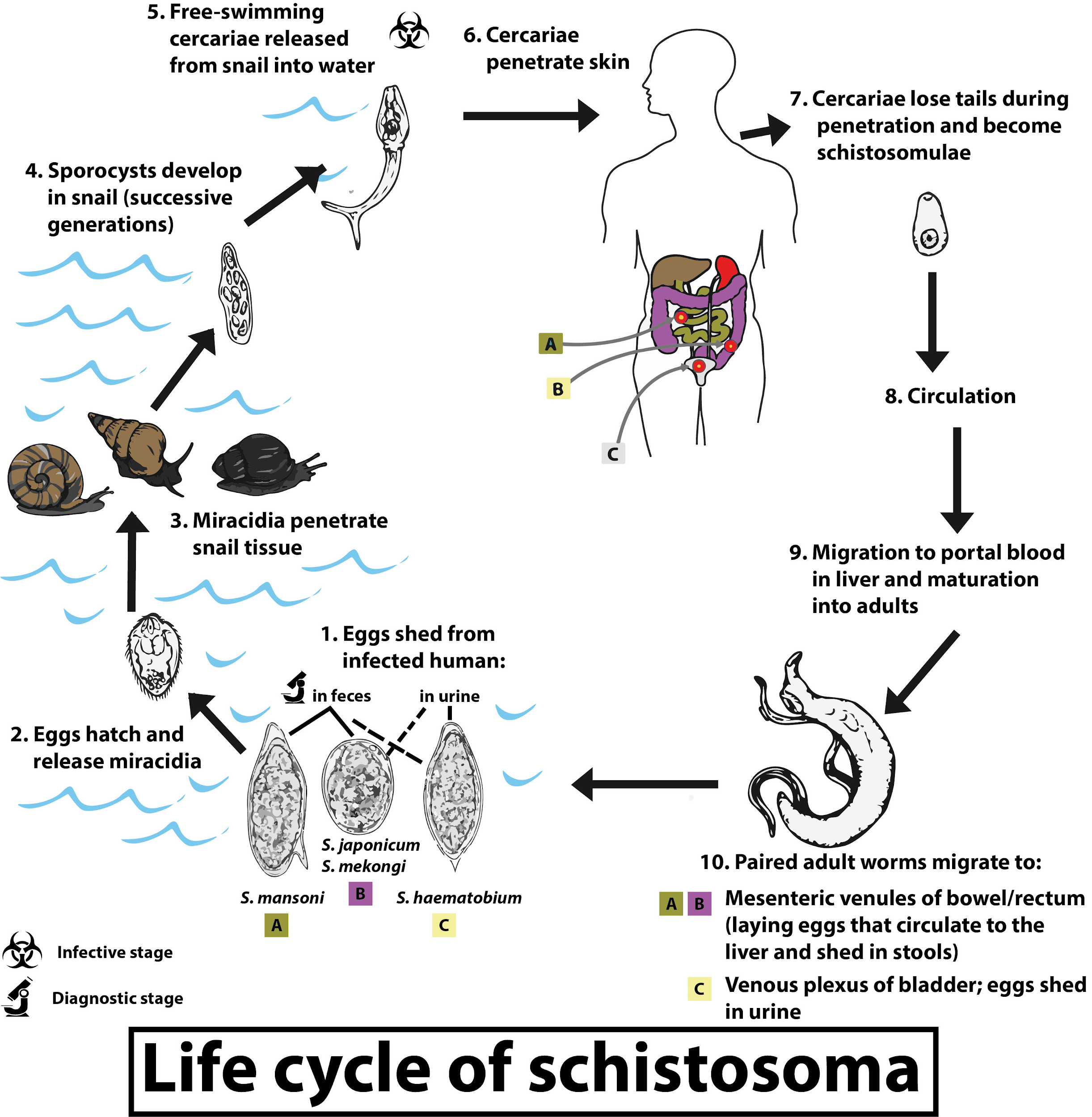
The intermediate host of Schistosoma is
(a)Snail
(b)Mosquito
(c)Housefly
(c)Sheep
Answer
564.6k+ views
Hint: Schistosoma also called blood flukes is caused by parasitic flatworms which are the reason for a major group of infections in humans called schistosomiasis having a characteristic feature that includes shell.
Complete answer:
The intermediate host of Schistosoma is the snail. The eggs of cercaria placed in the intestine will go out through urine and stool. A liberated kind of egg called the miracidium will penetrate the tissues of the intermediate host - snail. A snail is a Gastropod with a shell. Land snails and terrestrial pulmonate gastropod molluscs are what commonly included in the term ' snail' every thought there are a variety of marine snails.
Additional Information:
-Humans are affected by snails in different ways, like including edible products, pests in the crop, and as carriers of the disease.
-Their shells are also used as embroidery objects and are included in various jewellery. There are some snails without shells known as slugs.
-Snails are active and feed at night, majorly feeding on decaying organic matter, fungi, lichens, foliage, small worms Or centipedes, tiny insects, animal stool, carrion, and other slugs. Snails are known for feeding on other snails when food is scarce.
So, the correct answer is ‘snail’.
Note: -Snails are related to different parasitic diseases like schistosomiasis, angiostrongyliasis, paragonimiasis, fasciolopsiasis, opisthorchiasis, and fascioliasis which are known to infect humans.
-Schistosoma causes pain in the abdomen, joints, and muscles. Pain can occur while having sexual intercourse and urination.
-Gastrointestinal effects include bloating, blood in faeces, diarrhoea, and fluid in the stomach area. Other symptoms include body chills, fatigue, and fever.

Complete answer:
The intermediate host of Schistosoma is the snail. The eggs of cercaria placed in the intestine will go out through urine and stool. A liberated kind of egg called the miracidium will penetrate the tissues of the intermediate host - snail. A snail is a Gastropod with a shell. Land snails and terrestrial pulmonate gastropod molluscs are what commonly included in the term ' snail' every thought there are a variety of marine snails.
Additional Information:
-Humans are affected by snails in different ways, like including edible products, pests in the crop, and as carriers of the disease.
-Their shells are also used as embroidery objects and are included in various jewellery. There are some snails without shells known as slugs.
-Snails are active and feed at night, majorly feeding on decaying organic matter, fungi, lichens, foliage, small worms Or centipedes, tiny insects, animal stool, carrion, and other slugs. Snails are known for feeding on other snails when food is scarce.
So, the correct answer is ‘snail’.
Note: -Snails are related to different parasitic diseases like schistosomiasis, angiostrongyliasis, paragonimiasis, fasciolopsiasis, opisthorchiasis, and fascioliasis which are known to infect humans.
-Schistosoma causes pain in the abdomen, joints, and muscles. Pain can occur while having sexual intercourse and urination.
-Gastrointestinal effects include bloating, blood in faeces, diarrhoea, and fluid in the stomach area. Other symptoms include body chills, fatigue, and fever.

Recently Updated Pages
Master Class 12 Business Studies: Engaging Questions & Answers for Success

Master Class 12 Economics: Engaging Questions & Answers for Success

Master Class 12 English: Engaging Questions & Answers for Success

Master Class 12 Maths: Engaging Questions & Answers for Success

Master Class 12 Social Science: Engaging Questions & Answers for Success

Master Class 12 Chemistry: Engaging Questions & Answers for Success

Trending doubts
What is meant by exothermic and endothermic reactions class 11 chemistry CBSE

Which animal has three hearts class 11 biology CBSE

10 examples of friction in our daily life

One Metric ton is equal to kg A 10000 B 1000 C 100 class 11 physics CBSE

1 Quintal is equal to a 110 kg b 10 kg c 100kg d 1000 class 11 physics CBSE

Difference Between Prokaryotic Cells and Eukaryotic Cells




